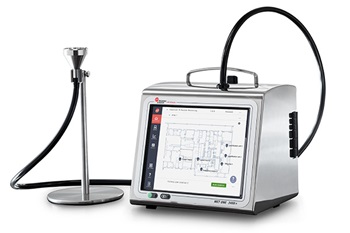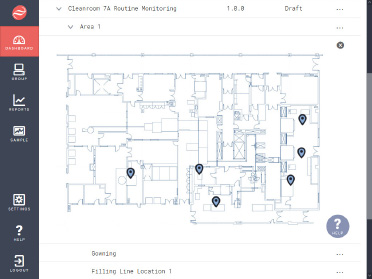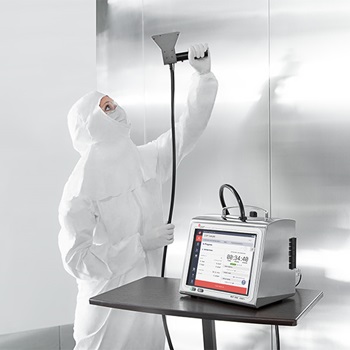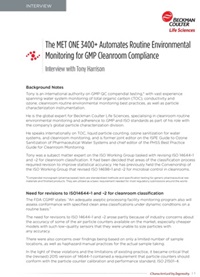The MET ONE 3400+ Automates Routine Environmental Monitoring for GMP Cleanroom Compliance
Interview with Tony Harrison
Background Notes
Tony is an international authority on GMP QC compendial testing,* with vast experience spanning water system monitoring of total organic carbon (TOC), conductivity and ozone, cleanroom routine environmental monitoring best practices, as well as particle characterization instrumentation.
He is the global expert for Beckman Coulter Life Sciences, specialising in cleanroom routine environmental monitoring and adherence to GMP and ISO standards as part of his role with the company’s global particle characterization division.
He speaks internationally on TOC, liquid particle counting, ozone sanitization for water systems, and cleanroom monitoring, and is former joint editor on the ISPE Guide to Ozone Sanitization of Pharmaceutical Water Systems and chief editor of the PHSS Best Practice
Guide for Cleanroom Monitoring.
 Tony was a subject matter expert on the ISO Working Group tasked with revising ISO 14644–1 and –2 for cleanroom classification. It had been decided that areas of the classification process required revision to improve statistical accuracy. He has previously held the Convenorship of the ISO Working Group that revised ISO 14698–1 and –2 for microbial control in cleanrooms.
Tony was a subject matter expert on the ISO Working Group tasked with revising ISO 14644–1 and –2 for cleanroom classification. It had been decided that areas of the classification process required revision to improve statistical accuracy. He has previously held the Convenorship of the ISO Working Group that revised ISO 14698–1 and –2 for microbial control in cleanrooms.
*Compendial monograph (pharmacopeial) tests are standardized methods and specification testing for generic pharmaceutical raw materials and finished products. They are utilized as a basic requirement needed for most regulatory submissions around the world.
Need for revisions to ISO14644–1 and –2 for cleanroom classification
The FDA CGMP states: “An adequate aseptic processing facility monitoring program also will assess conformance with specified clean area classifications under dynamic conditions on a routine basis.”
The need for revisions to ISO 14644–1 and –2 arose partly because of industry concerns about the accuracy of some of the air particle counters available on the market, especially cheaper models with such low–quality sensors that they were unable to size particles with any accuracy.
There were also concerns over findings being based on only a limited number of sample locations, as well as haphazard manual practices for the actual sample taking.
In the light of these violations and the limitations of existing practice, it became critical that the (revised) 2015 version of 14644–1 contained a requirement that particle counters should conform with the particle counter calibration and performance standard, ISO 21501–4.
Changes to ISO 14644–1
The fundamental changes in the ISO 14644–1:2015 document impacting on the GMP community are:
- Change to the method for calculating number of sample locations for classification/re–qualification.
- Elimination of the 95% Upper Confidence Limit (UCL) calculation.
- Reference to ISO 21501–4 in the normative* Annex A where the requirements for air particle counters are defined (*normative = must comply with this section).
- Removal of the maximum allowable concentration of airborne particles/m3
- ≥5microns for ISO Class 5 from the Cleanliness Classes table (ISO Class 5 at ≥5microns is equivalent to GMP Grade B at rest).
It is hoped that the new, stricter compliance requirements will lead to fundamental improvements to contamination–free manufacturing practices as part of the US CGMP and European GMP documents.
For more details see Tony Harrison’s ‘Changes to GMP force cleanroom re–classifications’ White Paper.
2018 FDA Guidance on 21 CFR part 11 Data Integrity Guidance for Industry
This stated: “In recent years, FDA has increasingly observed CGMP violations involving data integrity during CGMP inspections. These data integrity–related CGMP violations have led to numerous regulatory actions, including warning letters, import alerts, and consent decrees.
“Firms should implement meaningful and effective strategies to manage their data integrity risks based on their process understanding and knowledge management of technologies”. It adds that records should be “checked,” “verified,” or “reviewed".
The FDA ALCOA guidance refers to:
- A Attributable
- L Legible
- C Contemporaneously recorded
- O Original
- A Accurate
This guidance advises Quality Assurance managers to ask the following questions:
- Are controls in place to ensure that data is complete?
- Are activities documented at the time of performance?
- Are activities attributable to a specific individual?
- Can only authorized individuals make changes to records?
- Is there a record of changes to data?
- Are records reviewed for accuracy, completeness, and compliance with established standards?
Beckman Coulter Life Sciences MET ONE 3400+ portable GMP cleanroom air particle counter

The summary below shows how this fully automated instrument addresses 21 CFR part 11 ALCOA data records requirements by answering the following:
Are controls in place to ensure that data is complete?
Electronic SOPs and sampling maps are uploaded and configured in the MET ONE 3400+ air particle counter, with SOP version control also done in the counter. Completed sample locations turn green, allowing the user to see at a glance that the daily routine environmental monitoring program has been completed and no samples missed.
Are activities documented at the time of performance?
Electronic records of the day’s sampling activities are created contemporaneously in the MET ONE 3400+ counter and exported via Ethernet without the need for any external software, ensuring the activities are correctly documented at the time of performance.
Are activities attributable to a specific individual?
The MET ONE 3400+ utilizes Microsoft Active Directory for User Name and Password credentials control, and electronic signatures are attached to the electronic records that the counter creates, ensuring that activities and records are attributable to a specific individual.
Can only authorized individuals make changes to records?
The MET ONE 3400+ utilizes multi–level User Name and Password controls with configurable access rights to ensure only authorized personnel can make changes to records and any changes are recorded in the on–board Audit Trail.
Is there a record of changes to data?
Any changes are recorded in the on–board Audit Trail which can be quickly filtered and sorted to provide reports during audits.
Are records reviewed for accuracy, completeness, and compliance with established standards?
Remote review and approval of sampling data via web–browser by authorised personnel is done in the counter itself––and approved records with electronic signature sign–off are generated and exported straight from the counter via Ethernet, avoiding paper trails and manual data transcription.
Question to Tony Harrison
1. As a key member of the ISO working group who revised ISO 14644–1 and –2 for airborne contamination classification in cleanrooms – you set down significant changes impacting GMP cleanrooms by insisting on far stricter sampling requirements in the 2015 version. Why was this so important?
The challenge when designing a cleanroom is to ensure it has uniform air contamination levels in all locations – and to find ways of demonstrating this. It became clear to us that the 1999 version of the ISO standard required insufficient sampling locations to detect isolated pockets of contaminated air. It was therefore necessary to require companies to increase the number of locations where sampling had to take place. This would enable the company to obtain a more statistically sound picture of contamination levels in the entire room.
2. The FDA has been calling for effective strategies to manage data integrity risks for over 20 years. Can you describe some of the mistakes/errors that are a daily occurrence and why? Can the MET ONE 3400+ help prevent these errors?
The customers I’ve visited around the world tell me that it is very common for a cleanroom environmental monitoring team at a biopharmaceutical manufacturing site, such as a vaccine manufacturer, to collect many thousands of cleanroom air samples each month.
It is important to realise that sample–taking has been an intensely manual process, with the technicians having to perform numerous, time–consuming steps before they achieve a reading. It is almost impossible to avoid simple human error using such a manual process.
First, they have to follow a map of sampling locations for each cleanroom. Then, at each location they manually type the sample name into the counter, manually configure the sample size and number of samples to be taken, and print the results, handwriting comments about the sample on the paper print–out. Finally, they sign it, paper printouts are collated, and the information from each is manually transcribed into electronic format.
If you think about it, it is not surprising that the FDA is discovering errors in the final records and during their site audits they were even finding that samples were being overlooked in error.
3. The FDA ALCOA advice spells out what is going wrong and what needs to be done. How does the new MET ONE 3400+ help cleanroom environmental monitoring managers address the FDA’s ALCOA recommendations?
- A Attributable
- L Legible
- C Contemporaneously recorded
- O Original
- A Accurate
The new MET ONE 3400+ is designed to automate this manual process and help improve compliance with the FDA’s 21 CFR part 11 ALCOA guidance.
Electronic records are created contemporaneously inside the counter itself and are attributable to the technician, as he/she has to sign in to the counter using Microsoft Active Directory–controlled user name and password credentials.
Potentially illegible handwriting is avoided, as comments for each sample are typed directly into the electronic record by the technician through an onscreen qwerty keyboard to ensure they are legible.
The original electronic record is then remotely reviewed/approved as accurate inside the counter by the supervisor, using a web browser, and then exported from the counter via Ethernet or Wi–Fi. Accuracy is further confirmed by the built–in comprehensive audit trail.
4. What is unique about the MET ONE 3400+? How much of a breakthrough is it?
Other suppliers may have partially addressed some of the features you can see in the 3400+, but what stands out with the MET ONE is the way it automates the sampling process. It removes the risk of manual errors and improves workflow by saving time and reducing error.

It all has to do with the map.
Once sampling locations have been determined, all the user has to do is upload the map showing the sample locations into the counter to create an onscreen interactive sampling map. You only need to set this up once, and thereafter it simply becomes an electronic, onscreen, interactive guide every time sample monitoring takes place.
5. You say that it improves workflow – how exactly?
The onscreen interactive sampling map means that technicians now only have to go to each sampling location as shown on screen; they tap the location on the interactive map and the counter does the rest.
No more manually typing in location names, or manually configuring the counter for each location. At a stroke, this improves data integrity and helps ensure compliance with ALCOA.
Further time saving comes during the data review process. The supervisor can log on to the counter remotely via web browser to review/approve the day’s sampling results for completeness and accuracy. They then sign off with their electronic signature and trigger an export directly from the counter to a secure location across the company network.
6. The MET One automates data gathering. Why is that important?
With thousands of samples taken each month at each factory, it is very easy for human error to creep in. Automating the process helps reduce opportunities for human error that could lead to the risk of losing a batch due to incomplete/incorrect sample data.
7. Doesn’t someone still have to visit the different testing sites to monitor the emission of particles?
That’s right! We can’t automate that part, but we can ensure that all samples are taken. As each sample is complete, the sample location turns green on the screen and the technician can see at a glance if they have taken all the required samples and not missed one by accident.
8. How do you set up the system so that it functions automatically thereafter?
Set up is a one–off affair. Simply upload your Standard Operating Procedure (SOP) sampling map, assign sampling locations and program the counter with the sampling SOP requirements for each location. Once programmed the counter automates the sampling program without any further user intervention.
9. How easy is it to actually configure the SOP?
Another differentiating feature is that the standard operating procedure (SOP) version control is now done inside the counter. Administrators can log–on to the counter remotely using only a web browser, configure the current version of the SOP into the counter, assign a version number and then release the version for use using their Microsoft Active Directory Credentials. All routine sampling records contain the SOP name and version number used to take the sample.
10. Currently the demand is for research into vaccines for COVID–19. What difference can MET ONE make to this work?
The research arm of vaccine manufacturing does not fall under the same GMP scrutiny as the manufacturing sites.
Once an effective vaccine for COVID–19 is found, the MET ONE 3400+ will help the manufacturers ensure their facilities are in compliance so that there are no lost batches due to non–compliance and valuable supplies of the vaccine can get into the hands of the doctors and nurses who need to administer it.
 11. Compare the time it takes to set up the MET ONE 3400+ with the current manual processes currently performed by the industry. How much time can a user save?
11. Compare the time it takes to set up the MET ONE 3400+ with the current manual processes currently performed by the industry. How much time can a user save?
According to a survey conducted by Beckman Coulter Life Sciences, the biggest time savings comes from automating the review and approval process and eliminating manual data transcription from all those pieces of paper. This takes just a few minutes.
Customers told us that manual review and approval and manual data transcription processes can take up to 90 minutes per day, so that is a big time savings.
12. What have customers told you when they have seen a demonstration of the MET ONE 3400+?
The automated 3400+ design was based on customer feedback, when we asked them about the problems they were facing with manual routine environmental monitoring programs.
The customers I have shared the 3400+ functionality with have been visibly impressed. A common question I’ve received during demonstrations is “What? The SOP map appears actually on the counter screen and is automated? That is impressive!” The map on the screen seems to be the most impressive thing customers focus on during demonstrations.

